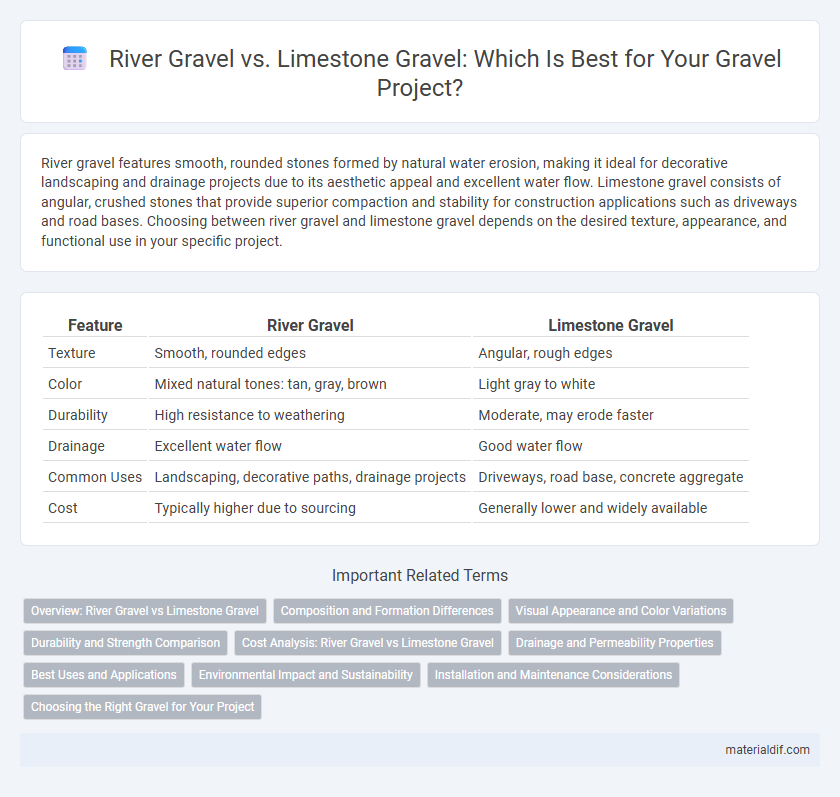River gravel features smooth, rounded stones formed by natural water erosion, making it ideal for decorative landscaping and drainage projects due to its aesthetic appeal and excellent water flow. Limestone gravel consists of angular, crushed stones that provide superior compaction and stability for construction applications such as driveways and road bases. Choosing between river gravel and limestone gravel depends on the desired texture, appearance, and functional use in your specific project.
Table of Comparison
| Feature | River Gravel | Limestone Gravel |
|---|---|---|
| Texture | Smooth, rounded edges | Angular, rough edges |
| Color | Mixed natural tones: tan, gray, brown | Light gray to white |
| Durability | High resistance to weathering | Moderate, may erode faster |
| Drainage | Excellent water flow | Good water flow |
| Common Uses | Landscaping, decorative paths, drainage projects | Driveways, road base, concrete aggregate |
| Cost | Typically higher due to sourcing | Generally lower and widely available |
Overview: River Gravel vs Limestone Gravel
River gravel is naturally rounded, exhibiting smooth textures and varied colors due to water erosion, making it ideal for landscaping and drainage applications. Limestone gravel, composed primarily of crushed sedimentary rock, features angular edges and a uniform light color, offering superior compaction and stability for construction and driveways. The choice between river gravel and limestone gravel depends on aesthetic preferences, drainage requirements, and load-bearing needs.
Composition and Formation Differences
River gravel consists primarily of rounded, smooth particles formed through natural water erosion and sediment transport processes, predominantly made of quartz, feldspar, and other durable minerals. Limestone gravel is composed chiefly of calcium carbonate from fragmented marine organisms, characterized by angular, rough textures formed through sedimentary rock weathering and crushing. These distinct compositions influence their respective durability and suitability for construction and landscaping applications.
Visual Appearance and Color Variations
River gravel features smooth, rounded stones with a naturally polished appearance due to water erosion, offering a diverse palette of earthy tones such as browns, grays, and tans. Limestone gravel presents more angular, rougher textures with a chalky surface, predominantly available in lighter shades like white, beige, and soft gray. These distinct visual and color variations influence their suitability for decorative landscaping and construction projects where aesthetic appeal is crucial.
Durability and Strength Comparison
River gravel exhibits superior durability due to its rounded edges and natural sedimentary processes, making it highly resistant to weathering and erosion. Limestone gravel, although strong with a higher compressive strength, tends to be more susceptible to chemical weathering and acid rain, which can reduce its longevity. The choice between river gravel and limestone gravel ultimately depends on the specific environmental conditions and structural requirements of the project.
Cost Analysis: River Gravel vs Limestone Gravel
River gravel generally incurs higher costs due to its natural sourcing and rounded, smooth texture, which increases processing and transportation expenses. Limestone gravel is typically more affordable because it is abundant, easier to quarry, and crushes into angular shapes that compact well for construction purposes. Cost differences also vary regionally, influenced by local availability, demand, and extraction methods.
Drainage and Permeability Properties
River gravel exhibits superior drainage and permeability properties compared to limestone gravel due to its rounded, smooth particles that allow water to flow freely between gaps. Limestone gravel, with its angular and porous composition, tends to retain water longer, reducing permeability and increasing drainage time. For landscaping and construction projects requiring efficient water runoff, river gravel offers better performance in managing moisture and preventing waterlogging.
Best Uses and Applications
River gravel provides smooth, rounded stones ideal for landscaping, pathways, and water features where natural aesthetics and drainage are important. Limestone gravel, characterized by its angular, rough texture, excels in construction applications like driveways, concrete aggregate, and road bases due to superior compaction and stability. Both materials offer durability, but river gravel is preferred for decorative purposes while limestone gravel suits structural projects.
Environmental Impact and Sustainability
River gravel, naturally smoothed and sourced from riverbeds, tends to have a lower environmental impact due to minimal processing and reduced dust emissions during extraction compared to limestone gravel. Limestone gravel extraction is often more energy-intensive and can lead to greater habitat disruption and increased carbon emissions from quarrying activities. Choosing river gravel supports sustainability by preserving biodiversity and reducing the carbon footprint associated with material transportation and processing.
Installation and Maintenance Considerations
River gravel offers smooth, rounded edges that facilitate easy installation and natural drainage, reducing the risk of water pooling and erosion. Limestone gravel, with its angular texture, compacts more firmly, providing a stable surface ideal for driveways and walkways but may require more frequent maintenance to prevent dust and weed growth. Both types need periodic raking to maintain appearance, but limestone gravel might demand occasional replenishment due to its tendency to break down under heavy traffic.
Choosing the Right Gravel for Your Project
River gravel features smooth, rounded stones ideal for landscaping and pathways due to its natural aesthetic and excellent drainage properties. Limestone gravel consists of angular, crushed stones offering superior compaction and stability, making it suitable for driveways and construction bases. Selecting the right gravel depends on project requirements such as drainage needs, load support, and desired appearance to ensure durability and functionality.
River gravel vs Limestone gravel Infographic

 materialdif.com
materialdif.com